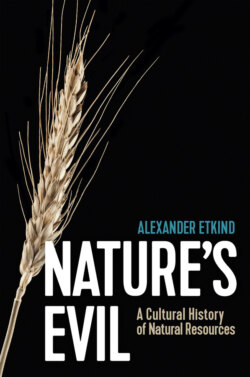Читать книгу Nature's Evil - Alexander Etkind - Страница 21
The grain hypothesis
ОглавлениеJames Scott poses an interesting question: what was it about cereals that made them central for agriculture? They are dry and storable, but so are lentils. In a mixed field, with cereals, beans and vegetables, different plants ripen at different times, and the peasants harvest them as they become ready. This is fine for subsistence but pretty inconvenient for taxation purposes. Therefore cereals underwent a historical process of selection, which set their biological clock so that myriad ears would ripen simultaneously. Already in ancient Mesopotamia, a field of ripe wheat had to be harvested in the space of a week. Then the tax collector could inspect, count and tax the harvest. Going round the fields, he valued the crop and took his cut (usually a tithe, but sometimes two tithes) to the state stores. Turning human beings into a means, the new state not only forced the peasants to plough the land but also prescribed what crop they were to plant. Overriding the objections or rebellions of the peasants, the authorities forced them to go over to growing cereal crops.
Uruk and other city-states with defensive walls, tax collection and an internal hierarchy emerged in the valleys of the Tigris and the Euphrates in about 3000 bce. Similar states appeared on the Nile, then on the Indus and in the Andes. The anthropologist Roberto Carneiro points out that these were all fertile but naturally isolated territories where, as chance would have it, farming was more productive than elsewhere.5 People fought over such favoured places, and they changed hands. Geographical variation defined the formation of states and their survival.
In Mesopotamia the preferred grain was wheat. Centuries of irrigation made the soil increasingly saline, and the heirs of Gilgamesh switched to millet. Ancient Athens depended on grain, supplied by sea from Egypt and Sicily. Chinese cities needed rice. In the sixth century they were already supplied by canals, which transported rice over distances of up to 2,000 kilometres. Wheat bread was always prized in Europe, but rye predominated in its northern regions. The Baltic trade in rye kept Holland and England supplied for hundreds of years. Canals, ports and granaries were built to accommodate this trade. Rivalling churches and palaces, these structures were the most complex that man could build at the time. The state collected taxes and guaranteed the storage of grain, taking on the responsibility of providing for its population in times of war or crop failure. Many revolutions, including the French and the Russian, began in response to the fact that the state granaries were empty.
Even today, four sorts of grain – wheat, rice, barley and maize – provide more than half the calories consumed by humankind. They are all crops that ripen simultaneously and they all have a long shelf life, making them suitable for trading and taxation purposes. But they are all very different. Unlike wheat or rye, rice grains are easily cooked, but rice flour doesn’t keep well. In China and other rice-dependent countries, hand mills were mostly sufficient for preparing the occasional meal that needed rice flour.6 For Europeans, wind- and watermills for grinding grain embodied technical proficiency and historical change.
